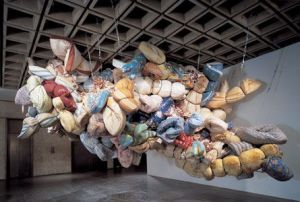Validating the Artist’s Intent Is Not Validating the Artist’s Word
by Andrea Romero
For some time now, I have been reflecting on what I believe ‘art’ to be and why. As an art historian, I always get questioned on why society values certain art that seems to be devoid of technique. Explaining originality and its value is easy. It is more difficult to explain how artworks that lack groundbreaking content and sophisticated technique can be art. Society’s approval is hard to contradict. The validation that a museum (or a ‘white wall’) grants to a piece further complicates the argument.
There is an interesting problem in the midst of all of this, the problem of all the contextual factors such as an institution’s reputation and an artist’s status. The brand of an artist and the name of an exhibiting institution mediate a viewer’s experience. However, not everything an artist makes is art; and not being able to discern when the artist does mean to fuels the uncertainty of what the term ‘art’ means.
I do not know if I will ever be able to draft a definition of ‘art’ that completely satisfies me. My reasoning leads me to a contradiction. For once, I believe that whether an object is art or not hinges on the intention of the artist; that is to say that only if an artist consciously intended to create art, something can be endowed with ‘the art essence.’ Of course, this does not mean that the artist actually succeeded in creating art – let alone good art. The conflict arises with my disbelief in the word of the artist. How can we prove that there is intent and purpose of ‘art- making’ behind a work? Certainly not by asking the artist himself. If an artist were to tell me that an object is meant to be art, I would not believe it. Artists are biased by their own creation processes and objectives. I particularly do not believe anything they tell me about the meaning of a piece. A work of art should speak for itself – if it does not convey what the artist wanted, then it did not fully succeed; and thus, it is not good art. But how do we measure if an artist succeeded in creating art at all? Intentions cannot be proven. Just because an object is treated as ‘art’ at any point during its existence (by hanging on a gallery’s wall, for example), it does not mean it was created to be so.
It would be too easy to reconcile the conflict by simply accepting that certain concepts are ineffable and that language is just a placeholder. Art exists – I will never debate that, but it is rather frustrating to be unable to define something I value so deeply. The realization that it is not a deficiency of the art but rather of the human constructs is not comforting. Art itself is a human creation, a human construct, after all. At the end, what art truly is does not change because of our inability to surpass its inexplicable meaning.
So my frustration lingers on.











